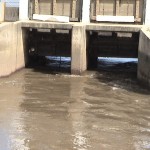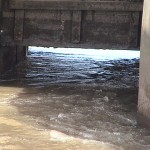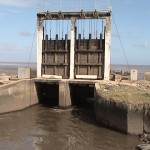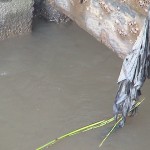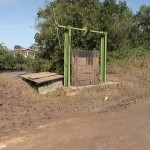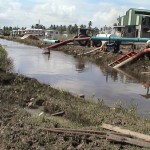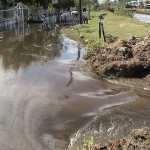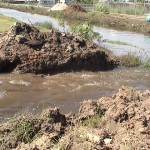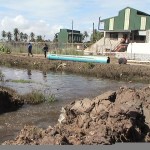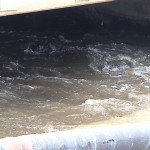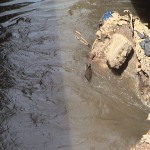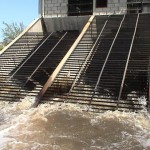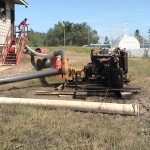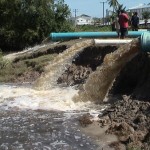The Ogle/Courida Park Sluices. PROVIDED BY MR. P
There are THREE SLUICES at OGLE/COURIDA PARK area which are fed with water PUMPED from the Ogle Pump Stations situated South of the East Coast Highway. There are additional pumps on the Ogle “Old Road” drawing water from the Ogle Navigation Relief Canal and discharging it into the Pump Discharge Channel.
TWO of the THREE SLUICES at that Ogle/Courida Park area which are
always open, are functional as these TWO replaced the single one to the West which is non-functional, useless and redundant.
To effectively pump water in this FLOOD CRISIS, you must be able to
discharge it THROUGH THE SEAWALL via a SLUICE or OVER THE SEAWALL.
As you drive along the East Coast and you come to the SHELL GAS STATION, you will approach the Ogle Pump Channel Bridges. 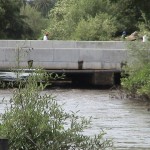
If you look over the bridge rails you will see water rushing North towards the two open sluices in the background at the Seawall. You will also see a gap between the bottom of the door and the top of the water at LOW WATER. See (a), (b), and (c).
If you pass SIX HOURS LATER you will find a FULL CANAL because the tide is now HIGH WATER, but the doors remain open and the pumping continues.
The Ogle Sluice allows for water in the navigation relief canal to be drained by gravity into the pump discharge channel at low water, while pumping is going on full bore – See (d), (e) and (f).
The dam was also cut to allow water to flow of 53.50 GD water by gravity into the navigation relief canal, which was being pumped as well as being drained by gravity via the pump discharge channel at LOW WATER. See (g), (h), (i).
When the new Ogle bridges were built, too much debris was left under the new structure so that there are further restrictions for efficient gravity drainage from the navigation relief sluice at LOW WATER. See (j) and (k) which shows the “waterfall or rapids” effect due to the obstructions.
Those TWO SLUICE DOORS at Ogle are never closed during pumping unless exceptionally high tides occur with heavy wave action that cause a swell in the channel behind the door, which can temporarily overtop the channel embankment. If they have to be closed it would be for not more than two or three hours at any one closing during the peak of the HIGH WATER. The Ogle pumps are some distance south of the East Coast Highway.
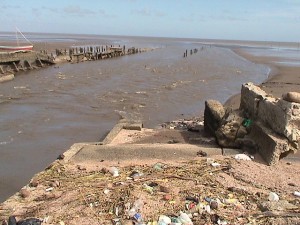 (l)
(l)
Years ago groynes extended well beyond the seawall on either side of the outfall channel. This kept the drift of sand and silt that came with each tide from a north east direction from clogging the outfall channel. It also kept the discharging water in a relatively narrow channel so that it retained its velocity and kept scouring the outfall channel.
Today, more pump stations are built to overcome the higher GD levels of the wider silted up outfalls as a result of the broken up groynes. Where there are no pumps, there is very restricted gravity drainage. So as the water leaves the Sluice it spreads out and loses it ability to maintain a velocity which scours the outfall channel.
For the sluices that drain by gravity, there is significant natural siltation on the outside of the door after any long dry season, and in a flood crisis at the beginning of the rainy season, the doors are difficult to raise and very little water can pass over the high GD of the silted up outfall.
To effectively pump water in this FLOOD CRISIS, you must be able to
discharge it THROUGH THE SEAWALL via a SLUICE or OVER THE SEAWALL.



